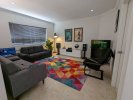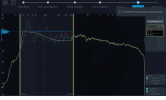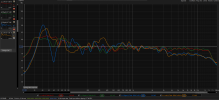Hi all,
As per the subject heading, I've been trying to get into the audiophile world but struggling with some of the basics and was hoping to get some help.
I recently purchased a pair of KEF R3 Metas and paired it with the NAD M10v2. Probably getting close to around 50 hours use now and whilst they sound good, they dont wow me like I was hoping they would (maybe my expectations were too high, but I also fear room characteristics are probably a large limiting factor too). Room is approx 4.3 x 4.5m, with a small diagonal wall which opens back into the kitchen/dining area. Behind the main listening area is a window of similar size as to the other window shown in the photo, as you can see also the right speaker is also pretty close to my aquarium!
I've just spent the morning running DIRAC with a UMIK-1 microphone (whilst also trying to get my head around frequency responses, target curves etc etc) but I'm still not really sure what to make of the results. I'd appreciate if anyone can give me advice as to any improvements I may be able to make either to the room or to the DIRAC settings.
As per the subject heading, I've been trying to get into the audiophile world but struggling with some of the basics and was hoping to get some help.
I recently purchased a pair of KEF R3 Metas and paired it with the NAD M10v2. Probably getting close to around 50 hours use now and whilst they sound good, they dont wow me like I was hoping they would (maybe my expectations were too high, but I also fear room characteristics are probably a large limiting factor too). Room is approx 4.3 x 4.5m, with a small diagonal wall which opens back into the kitchen/dining area. Behind the main listening area is a window of similar size as to the other window shown in the photo, as you can see also the right speaker is also pretty close to my aquarium!
I've just spent the morning running DIRAC with a UMIK-1 microphone (whilst also trying to get my head around frequency responses, target curves etc etc) but I'm still not really sure what to make of the results. I'd appreciate if anyone can give me advice as to any improvements I may be able to make either to the room or to the DIRAC settings.




